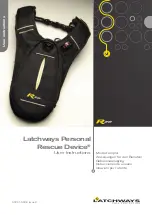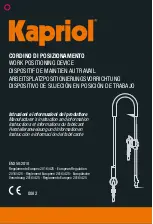
3
Operating Instructions and Parts Manual
27069
COOLING SYSTEM
PRESSURE TEST PUMP
NOTE:
The manufacturer declines any and all responsibility for
damage to vehicles or components if said damage is the result
of unskillful handling by the operator or of failure to observe the
basic safety rules set forth in the instruction manual.
WARNING
Read Rules for Safe Operation and Instructions Carefully.
Important Safety Instructions
The warnings, precautions, and instructions discussed in this
manual cannot cover all possible conditions and situations that
may occur. The operator must understand that common sense
and caution are factors which cannot be built into this product, but
must be supplied by the operator.
Disposal
At the end of the useful life of the OEMTOOLS
®
Cooling System
Pressure Test Pump dispose of the components according to all
state, federal and local regulations.
Purpose
The OEMTOOLS
®
Cooling System Pressure Test Pump is designed
to diagnose and help locate leaks in an automotive cooling
system, allowing the user to manually pressurize and monitor a
cooling system. Leaks are indicated by a drop in pressure over
a few seconds or minutes. The location of an external leak is
pinpointed by the visible signs of coolant. Internal leaks, which
may not be visible, typically indicate a blown head gasket or
damaged block or head and can be diagnosed with a Block Tester
(purchased separately) that detects Combustion Gases in the
cooling system.
Cooling System Pressure Test Pump Instructions:
NOTE:
Refer to the vehicle’s service manual for specific cooling
system pressure testing instructions before use.
WARNING
Never remove cooling system cap from a hot engine. Hot coolant
under pressure can cause severe injury. Test system pressure
by squeezing the cooling system hoses. They should be easy to
squeeze. If not, wait until the vehicle has cooled down and the
system pressure has equalized.
1. Loosen the vehicle’s radiator cap slowly to relieve any excess
pressure before removing the cap completely.
2. Check to see that the radiator or coolant bottle is filled to the
proper level, and check hoses for visual damage or leaks. Fill
and repair as necessary prior to testing.
3. Securely attach the Pump to the filler neck of the radiator or
expansion tank.
NOTE:
On some vehicles an adapter may be required
to connect the Cooling System Pressure Test Pump to the
vehicle’s cooling system
Adapters are not included and can be purchased separately
from OEMTOOLS
®
.
NOTE:
To attach the pump to the adapter or cooling system,
insert into adapter or cooling system opening. While pressing
down turn the tester head LEVER clockwise until the LEVER
climbs up (Figure A) and over the ramps.
Once fully engaged and sealed, the LEVER will be between the
ramps and loose. (Figure B)
FIGURE A
FIGURE B
4. Operate the Pressure Pump until the needle on the pressure
gauge moves to the end of the colored band indicating the
appropriate pressure specified by the vehicle manufacturer.
WARNING
Pressurize the cooling system up to the vehicle manufacturer’s
specifications only.
DO NOT OVER PRESSURIZE THE COOLING SYSTEM.
WARNING
With the system still pressurized, perform a visual inspection
of the entire cooling system. Check hoses and connections for
seepage, which would indicate a leak. Return to the gauge and
check the reading once more.
• Needle holds steady – If gauge hand holds at the same
pressure for 2 minutes, there are no serious leaks in the
system. Smaller leaks may take longer.
• Needle drops slowly – Indicates the presence of the small
leaks or seepage.
• Needle drops quickly – Indicates serious leakage is present.
5. Once testing is complete, release pressure in the cooling
system by turning the tester head LEVER clockwise until it is
centered on the ramps. Pressure will release.
6. Once you verify by looking at the gauge that all the pressure is
released, turn tester HEAD counterclockwise to remove from
the adapter or cooling system.
7. Remove adapter if used, refill cooling system to the proper
level and reinstall the cap.
11/16
2016 OEMTOOLS
®






















